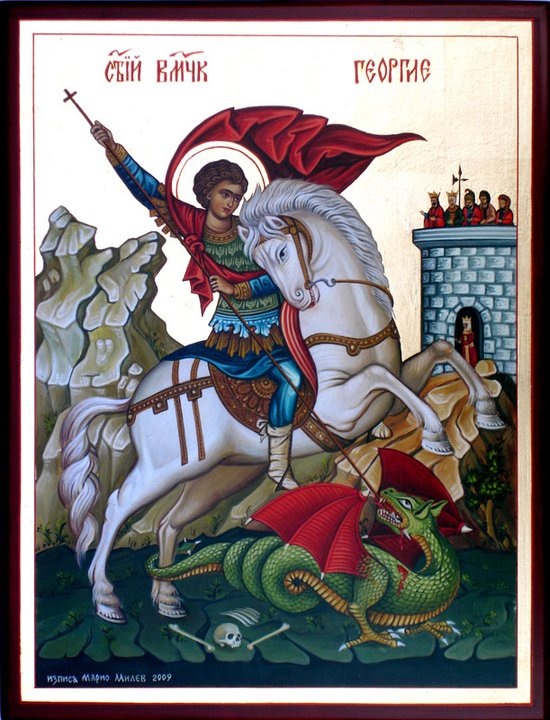About us
Our parish is a part of the Russian Orthodox Church, whose current first hierarch is Patriarch Kirill of Moscow. We are part of the Russian Orthodox Church Outside of Russia, whose first hierarch is Metropolitan Hilarion of New York and Eastern America. The parish is located in the Western American Diocese, led by archbishop Kyrill of San Francisco and Western America. Our deanery, the northwest deanery, is led by bishop Theodosy of Seattle. Our rector is archpriest Michael van Opstall. Our warden since 2016 is Igor Birioukov. The choir is under the direction of Catherine Norman.
The Holy Great-Martyr George the Trophy-Bearer

Commemorated on April 23
The Holy Great-Martyr George the Trophy-Bearer, was a native of Cappadocia (a district in Asia Minor), and he grew up in a deeply believing Christian family. His father had accepted a martyr's death for Christ, when George was yet a child. His mother, owning lands in Palestine, resettled there with her son and raised him in strict piety.
Having grown up, Saint George entered into the service of the Roman army. He was handsome, brave and valiant in battle, and he came to the notice of the emperor Diocletian (284-305) and was accepted into the imperial guards with the rank of "comites" – one of the higher military officer ranks.
The pagan emperor, while having done much for the restoration of Roman might, and who was quite clearly concerned, as to what sort of danger the triumphing of the Crucified Saviour might present for pagan civilization, in especially the final years of his reign intensified his persecution against the Christians. Upon the advice of the Senate at Nicomedia, Diocletian afforded all his governors full freedom in their court proceedings over Christians and in this he promised them all possible help. Saint George, having learned about the decision of the emperor, distributed to the poor all his wealth, set free his servants, and then appeared in the Senate. The brave soldier of Christ spoke out openly against the emperor's designs, he confessed himself a Christian and appealed to all to acknowledge the true faith in Christ: "I am a servant of Christ, my God, and trusting on Him, I have come amidst ye at mine own will, to witness concerning the Truth". "What is Truth?" – one of the dignitaries said, in repeating the question of Pontius Pilate. "Truth is Christ Himself, persecuted by ye", – answered the saint.
Stunned by the bold speech of the valiant warrior, the emperor – who loved and had promoted George, attempted to persuade him not to throw away his youth and glory and honors, but rather in the Roman custom to offer sacrifice to the gods. To this followed the resolute reply of the confessor: "Nothing in this inconstant life can weaken my resolve to serve God". Then by order of the enraged emperor the armed-guards began to jostle Saint George out of the assembly hall with their spears, and they then led him off to prison. But the deadly steel became soft and it bent, just as the spears would touch the body of the saint, and it caused him no hurt. In prison they put the feet of the martyr in stocks and placed an heavy stone on his chest.
The next day at the interrogation, powerless but firm of spirit, Saint George again answered the emperor: "Thou wilt become exhausted sooner, tormenting me, than I being tormented of thee". Then Diocletian gave orders to subject Saint George to some very intense tortures. They tied the Great-Martyr to a wheel, beneath which were set up boards inset with sharp pieces of iron. With the turning of the wheel the sharp edges tore at the bare body of the saint. At first the sufferer loudly cried out to the Lord, but soon he quieted, not letting out even a single groan. Diocletian decided that the tortured one was already dead, and he gave orders to remove the battered body from the wheel, and set off then to a pagan temple to offer a thank-offering. But at this very moment it got dark all over, thunder boomed, and a voice was heard: "Fear not, George, for I am with thee". Then a wondrous light shone, and at the wheel appeared an Angel of the Lord in the form of a radiant youth. And just as he lay his hand upon the martyr, saying to him: "Rejoice!" ‑- Saint George stood up healed. And when the soldiers led him off to the pagan temple, where the emperor was, the emperor could not believe his own eyes and he thought, that in front of him was some other man or even a ghost. In confusion and in terror the pagans looked Saint George over carefully, and they became convinced, that actually a miracle had occurred. Many thereupon came to believe in the Life-Creating God of the Christians. Two illustrious officials, Saints Anatolios and Protoleon, – secretly Christians, therewith openly confessed Christ. And right away, without a trial, by order of the emperor they were beheaded with the sword. Present also in the pagan temple was the Empress Alexandra, the wife of Diocletian, and she too knew the truth. She was on the point of glorifying Christ, but one of the servants of the emperor took her and led her off to the palace.
The emperor became all the more furious. But not having lost all hope of swaying Saint George, he gave him over to new quite fierce torments. Having thrown him down a deep pit, they covered it over with lime. Three days later they dug him out, but found him cheerful and unharmed. They shod the saint in iron sandals with red-hot nails, and with blows they drove him back to the prison. In the morning, when they led him back to the interrogation, cheerful and with healthy feet, he said to the emperor, that the sandals had fit him. Then they beat him with ox-thongs so much, that his body and blood became mingled with the ground, but the brave sufferer, strengthened by the power of God, remained unyielding.
Having decided, that magic was helping the saint, the emperor summoned the sorcerer Athanasias, so that he should try to deprive the saint of his miraculous powers, or else poison him. The sorcerer gave Saint George two goblets with drugged ingredients, the one of which should have quieted him, and the other – to kill him. But the drugs also did not work – and the saint as before continued to denounce the pagan superstitions and glorify the True God. To the question of the emperor, what sort of power it was that helped the saint, Saint George answered: "Think not, that the torments do me no harm thanks to human powers, – I am saved only by calling upon Christ and His Power. Whoso believeth on Him hath no regard for tortures and is able to do the deeds, that Christ did" (Jn. 14: 12). Diocletian asked, what sort of deeds were they that Christ did. – "To give sight to the blind, to cleanse the leprous, to grant walking to the lame, and to the deaf – hearing, to cast out devils, and to raise up the dead".
Knowing, that never whether by sorcery, nor by any of the gods known to him, never had they been able to resurrect the dead, and wanting to test the trust of the saint the emperor commanded him to raise up a dead person right in front of his eyes. To this the saint replied: "Thou wouldst tempt me, but for the salvation of the people which shalt see the deed of Christ, my God wilt work this sign". And when they led Saint George down to the graveyard, he cried out: "O Lord! Show to those here present, that Thou art the One-Only God throughout all the world, let them know Thee as the Almighty Lord". And the earth did quake, a grave opened up, the dead one came alive and emerged from it. Having seen with their own eyes the Almighty Power of Christ, the people wept and glorified the True God. The sorcerer Athanasias, falling down at the feet of Saint George, confessed Christ as the All-Powerful God and besought forgiveness of his sins, committed in ignorance. The obdurate emperor in his impiety thought otherwise: in a rage he commanded to be beheaded both the new-believer Athanasias and likewise the man resuscitated from the dead, and he had Saint George again locked up in prison. The people, weighed down with their infirmities, began in various ways to penetrate the prison and they there received healings and help from the saint. There resorted to him also a certain farmer named Glycerios, whose ox had collapsed. The saint with a smile consoled him and assured him, that God would restore his ox to life. Seeing at home the ox alive, the farmer began to glorify the God of the Christians throughout all the city. By order of the emperor, Saint Glycerios was arrested and beheaded.
The exploits and the miracles of the Great-Martyr George had increased the number of the Christians, and therefore Diocletian decided to make a final attempt to compel the saint to offer sacrifice to the idols. They began to set up a court at the pagan temple of Apollo. On the final night the holy martyr prayed fervently, and when he dozed off, he beheld the Lord Himself, Who raised him up with His hand, and hugged him in giving him a kiss of greeting. The Saviour placed on the head of the Great-Martyr a crown and said: "Fear not, but rather make bold and be vouchsafed My Kingdom".

In the morning at the court the emperor offered Saint George a new test – he proposed to him to become his co-emperor. The holy martyr with a feigned willingness answered, that from the very beginning the emperor had seemed inclined not to torture him but rather shew mete mercy, and with this he expressed the wish to go forthwith into the pagan temple of Apollo. Diocletian decided, that the martyr was accepting his offer, and he followed after him into the pagan temple with his accompanying retinue and the people. Everyone waited, whether Saint George would offer sacrifice to the gods. He however, in going up to the idol, made the sign of the Cross and turned towards it, as though it were alive: "Thou wishest to receive from me sacrifice befitting God?" The demon inhabiting the idol cried out: "I am not God and none of those like me are God. The One-Only God is He Whom thou preachest. We are of those servant-angels of His, which became apostate, and in the grips of jealousy we do tempt people". "How dare ye to be here, when hither have come I, the servant of the True God?" – asked the saint. Then was heard a crash and wailing, and the idols fell down and were shattered. There began a general confusion. In a frenzy pagan-priests and many of the throng pounced upon the holy martyr, they tied him up and began to beat him and demand his immediate execution.
Into the noise and the shouts rushed the holy empress Alexandra. Pushing her way through the crowd, she cried out: "Thou God of George, help me, in as Thou Alone art All-Powerful". At the feet of the Great-Martyr the holy empress glorified Christ, Who had humiliated the idols and those worshipping them. Diocletian in a rage immediately pronounced the death sentence against the Great-Martyr George and the holy Empress Alexandra, who without being accompanied, followed Saint George to execution. Along the way she collapsed and slumped senseless against a wall. Everyone thought, that the empress was dead. Saint George offered up thanks to God and he prayed, that he should end his path worthily. At the place of execution the saint in heated prayer besought the Lord, that He would forgive the torturers that knew not what they did, and that He would lead them to the knowledge of Truth. Calmly and bravely, the holy Great-Martyr George bent his neck beneath the sword. This occurred on 23 April 303.








